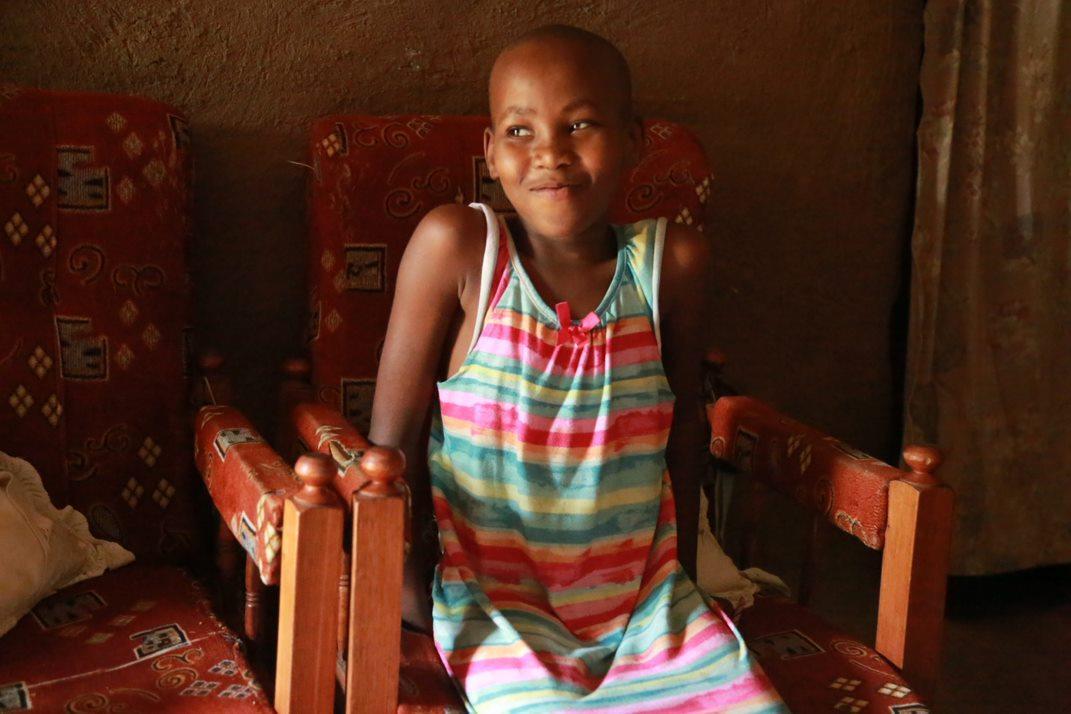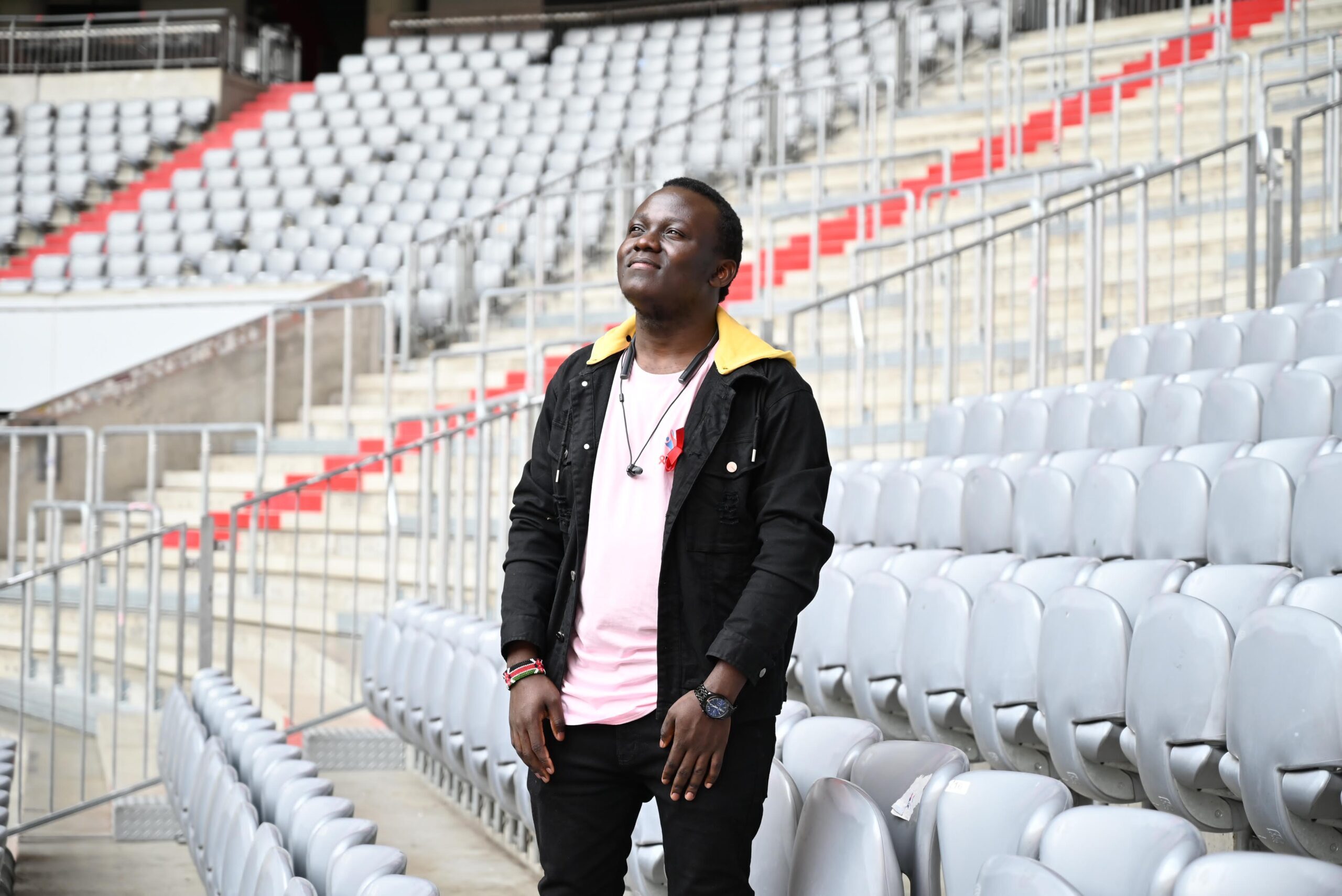“I am tired, and life is very stressful; I am aging, and my body is no longer strong,” says Roslin Achieng, a 65-year-old caregiver who lives in Homabay, Kenya. “My biggest worry is for these kids. My son and his wife died and left me with three kids—all three are HIV positive, and one of them has polio.
“I don’t know who will take care of them when I am gone. I have struggled with them, but now that I am losing my strength, I am very worried.”
Achieng’s story is not unique in Kenya, where approximately 3.6 million children (under the age of 18) have lost one or both parents—nearly half of them from HIV-related illnesses. Most of the orphaned children are also faced by poverty, disease, abandonment, natural disasters, among other environmental and societal crises.
Health, Stability, Schooling, and Safety
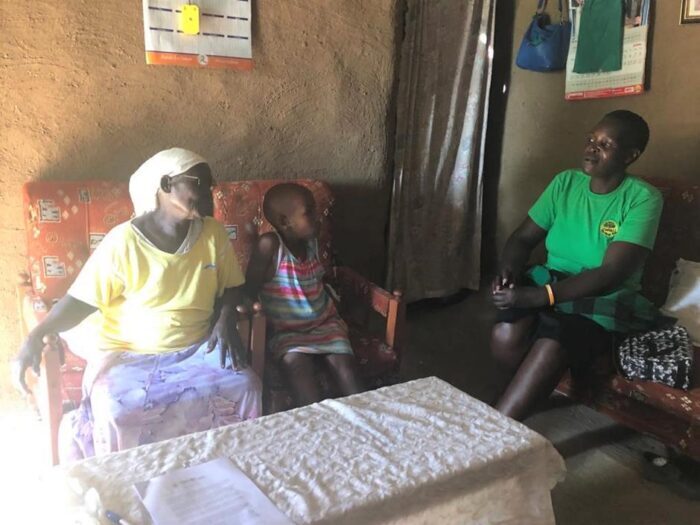 Roslin Achieng and her granddaughter, Evaline Awuo, during a home visit by Jacline Achieng, a community health worker in Ngegu. Photo by Charity Mureithi, Elizabeth Glaser Pediatric AIDS Foundation 2022
Roslin Achieng and her granddaughter, Evaline Awuo, during a home visit by Jacline Achieng, a community health worker in Ngegu. Photo by Charity Mureithi, Elizabeth Glaser Pediatric AIDS Foundation 2022
To reduce the concerns of caregivers like Achieng and improve the outcomes of orphaned children, the Elizabeth Glaser Pediatric AIDS Foundation (EGPAF) is working with LVCT Health, a local organization with a mission to empower communities. Through the Vukisha 95 project—which is funded by the U.S. Centers for Disease Control and Prevention (CDC)—the two organizations are linking orphans living with HIV to care and safety. LVCT is the prime recipient for the grant supporting the overall program management, while EGPAF offers technical assistance for the program. The program focuses on four pillars outlined by the CDC: health, stability, schooling, and safety.
Health is the lens for identifying gaps at the household level for better health outcomes. Typical services include HIV testing and counseling, nutritional support, immunization, and linking to other health services.
The stability pillar looks at managing the economic outcomes of the family to ensure they are able to meet their basic financial needs through support to start and grow income-generating activities.
Safety looks at the care environment of the child, ensuring they are safe and are linked to care mechanisms—and that the household is informed on child protection and how to reporting abuse.
Schooling looks at ensuring that children are in school and are supported with school supplies and other educational needs.
“Our focus in this project is care and treatment, with the point of entry being HIV-positive children identified through the health facilities,” says Phyllis Mboi, technical advisor on Orphans and Vulnerable Children (OVC) for EGPAF. “We [are] guided by the curriculum developed by the U.S. President’s Emergency Fund for AIDS Relief (PEPFAR).” (Examples of the curriculum include Family Matters for Caregivers with Children and Healthy Choices for a Better Future.)
“The goal is to support these children to thrive within their contexts,” says Mboi, “and, thus, we evaluate and develop a case-by-case plan for each of the four parameters to help improve their outcomes, working through community health volunteers for effective implementations.”
The Vital Human Connection
“My day-to-day work involves being a link between the facility and the household,” says Jacqueline Oduor, a community health volunteer under the project. “This involves visiting households, following up on cases from the facility for adherence monitoring and the overall welfare of the child. I also conduct assessments and make recommendations for follow-up.”
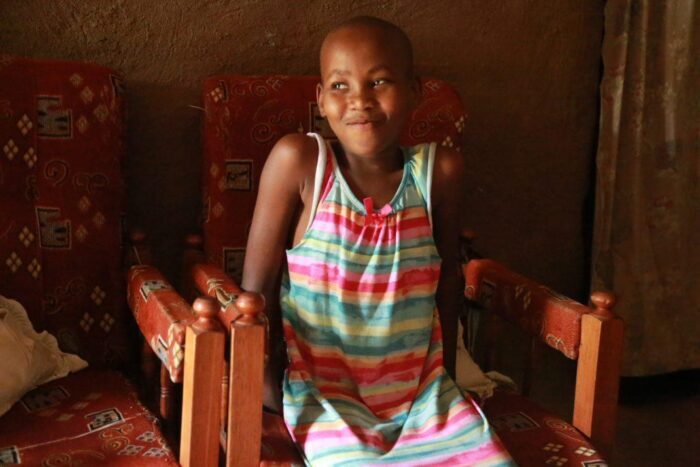 Evalien Awuor, a beneficiary of the Vukisha 95 OVC project. Photo by Charity Mureithi, Elizabeth Glaser Pediatric AIDS Foundation 2022
Evalien Awuor, a beneficiary of the Vukisha 95 OVC project. Photo by Charity Mureithi, Elizabeth Glaser Pediatric AIDS Foundation 2022
An example of the project at work can be seen in the household of Roslin Achieng.
Achieng’s 10-year-old granddaughter Evaline lives with her grandmother along with two siblings. All three of the children are living with HIV. Evaline faces challenges at school, and the community health volunteer helps her navigate those difficulties.
“Initially I was taking my medication at school during weekdays, and children would laugh at me,” says Evaline. “The teachers also used to wonder why I would go to the hospital every so often because they did not know about my condition. The [community health volunteers] helped us by speaking to the hospital, and now I get my medication on Sundays. My grandmother helps me to take my medication at 7 p.m., after school, and I am better.”
Mboi notes that this kind of household support highlights the complementary role that community health workers can play in the community.
Improved Economic Outcomes
Working with local implementers like Mango Tree Orphan Support, Vukisha 95 also looks out for the economic wellbeing of children and households that have lost one or more parent. The organization assists children through its rescue center and school program. It advocates for child-friendly services. And it helps caregivers raise their income.
“The Vukisha 95 project continues to improve the well-being of children, having a huge impact on the health and education of our children,” says David Omurie, Mango Tree coordinator. “EGPAF and LVCT have improved our human resource capacity through training and institution system strengthening.”
“I was connected to Mango Tree to get the support I needed for my firstborn,” says Beatrice Adhiambo, a widow and mother of three.
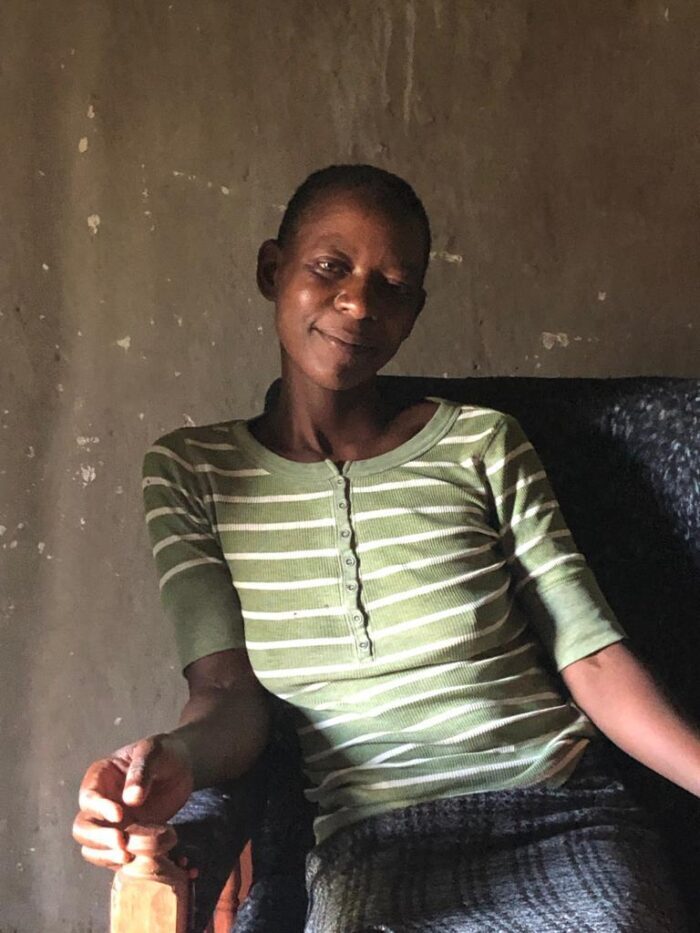
“They empowered me to start a business to help improve our quality of life. They helped me develop a business plan and gave me start-up capital for my [fishmonger] business.
“The business has since helped me pay school fees and put food on the table. My child has also been accessing counseling services and is supported to be in school. I am very grateful. I also joined a savings and lending group that helps me in case of emergencies.”
Omurie points out that a gap, however, remains as adolescents reach adulthood.
“We are supposed to transition children out of the program at 18 years and hand them over to the community,” says Omurie. “But this is still a challenge because some of these children have nowhere to go. Some of the children have disabilities, and getting foster care for them is hard. Some children have adherence challenges and there aren’t enough rescue centers to take them for continued support”
These issues notwithstanding, Vukisha 95 connects households, health centers, local nonprofits, and community health workers to care for and support children in the community who might otherwise be missed—as well as caregivers who may be overwhelmed by circumstance.
“Every child needs a sense of belonging, an opportunity to be a child, and to embrace the joys of being just that,” says Charity Mureithi, EGPAF-Kenya’s communications and advocacy officer. “The African child continues to grapple with challenges that rob them of this opportunity. Countries like Kenya continue to bear the brunt of HIV and AIDS, with children continuing to be orphaned.
“We appreciate the support accorded by the children’s department, the Ministry of Education, the Ministry of Health, the Ministry of Agriculture, the Judiciary, and the entire community,” says Mureithi. “Through our partnerships we continue to make a difference in these children’s lives.”

